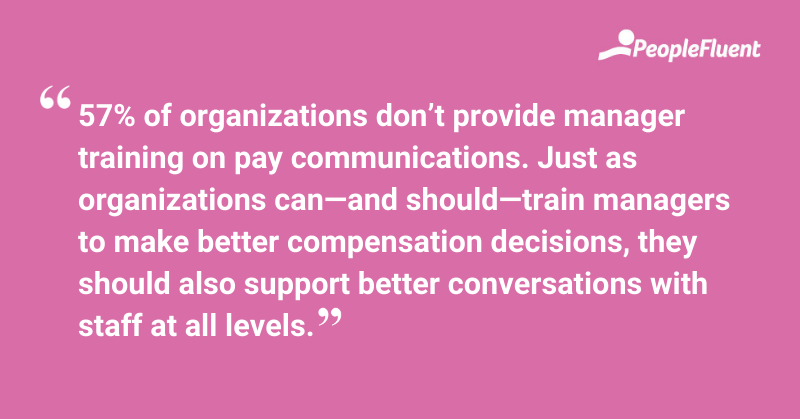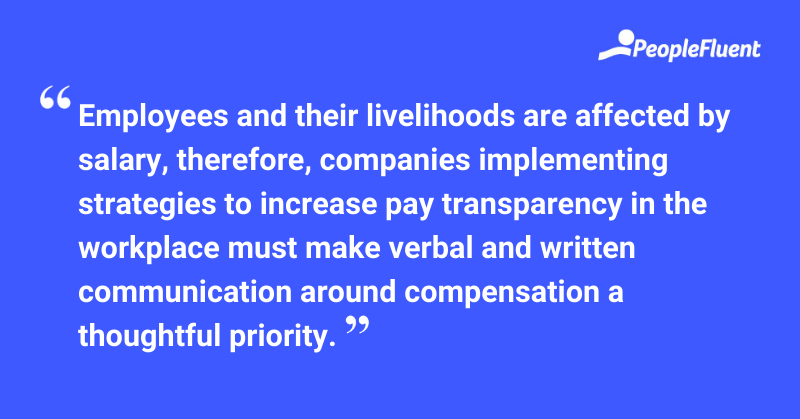Published: Nov 1, 2021Time to read: 6mins Category: Compensation
4 Secrets to Pay Transparency Success
The words ‘pay’ and ‘transparency’ make it pretty obvious that pay transparency is the sharing of employee compensation data, both internally and externally amongst employees. But the bigger question is: why would an organization want to share such sensitive data? It’s a really important question—one that will help your organization balance the pros and cons of sharing what has (historically) been closely guarded information.
With diversity, equity, and inclusion (DE&I) a top initiative for many companies, pay transparency can help management identify any bias you may have in your compensation strategies and fix those issues. This, in turn, builds the confidence and loyalty of your employees. The old adage ‘put your money where your mouth is’ helps you turn DE&I initiatives into real-life impact—instead of just sounding good to stakeholders.
Pay transparency can also be helpful in the recruitment process. If you’re willing to be transparent with your salary information, you’re more likely to have competitive wages and more likely to attract top talent—plus retain that talent. It says to candidates, ‘we know what you're worth and we’re willing to pay you for it’.
YOU MIGHT ALSO LIKE | ‘4 Dangers of Only Using Spreadsheet Templates for Compensation Planning’
Adding Context to Pay Equity Conversations
Since many factors make up a total rewards package, it’s possible for pay differences to be taken out of context. The reason for these differences might not be obvious at first glance, so it’s vital you add context to the compensation info you’re giving your people.
By explaining pay and pay practices—such as the relationship between pay and experience, performance, skills and qualifications, and other data—you can build trust between employee and organization, and thereby increase employee loyalty and engagement.
Even if you’re not ready to jump into an open salary strategy, it doesn’t have to be an all-or-nothing approach. There are ways to implement and ease into the appropriate levels of transparency for your organization.
Keep reading for the four strategies of pay transparency success.

MORE FROM THE BLOG | ‘Having Difficult Hiring Conversations? Not Anymore! 5 Ways to Negotiate Compensation and Land Your Candidate’
1. Explain the Underlying Strategy
At the most basic level, the organization can educate employees on its compensation strategy. Understanding the strategy gives your people some perspective on how compensation ties into the values of the organization, and empowers them to find ways to further contribute to the organization and increase their compensation.
Each individual in the organization will prefer a different style of communication. That’s why HR and compensation leaders should make giving and providing feedback easier. This starts with training and empowering managers to discuss compensation (more about that later!) and creating spaces for them to do that effectively.
With that said, we recommend that you define your strategy based on data as well as employee feedback. That way, you’re better equipped to provide accurate information and have transparent discussions with managers and staff.
2. Share Market Information and Explain Your Process
The next level is to provide employees with market studies and information on your compensation process. By publishing market studies, you can raise employee understanding of compensation ranges and market impacts on those ranges. In this way, you can show that their paycheck is thoughtfully and carefully planned.
GET THE FREE RESOURCE | ‘RFP Checklist for Compensation Pros: Know What to Ask to Get Exactly What You Need’
3. Train Managers to Talk About Compensation
In addition to providing valuable context, compensation teams can influence interactions between managers and employees.
As the first-line resource for workers, managers often field questions and hold discussions around compensation. However, a recent PayScale study found that 57% of organizations don’t provide manager training on pay communications. Just as organizations can—and should—train managers to make better compensation decisions, they should also support better conversations with staff at all levels.
For example, info on performance, experience, market data, and other key metrics can help managers make better and more objective compensation decisions. And managers can leverage conversations with their employees to explain their compensation level and coach them to earn an increase.
The return can be two-fold: the employee gets a greater understanding of their compensation and the path to a pay increase, and their motivation to pursue a pay increase can drive improvements in business performance.

YOU MIGHT ALSO LIKE | 'The Top 4 Benefits of Using Compensation Management Software'
4. Balancing Transparency and Confidentiality
You might be using several different strategies to address the need to increase pay transparency while maintaining all-important confidentiality. By way of example, let’s look at a utility company that has a unique strategy for raising visibility and transparency into its compensation process—focusing on managers and improving awareness around its compensation recommendations.
As part of the planning process, the company developed a series of reports and made them available to all decision-makers. These reports provided a visual representation of how the decision-makers’ recommendations aligned with peer groups, other business units, and the company as a whole.
This data enabled managers to ensure that any material outliers made sense or were addressed, thereby increasing the level of pay transparency among decision-makers and improving the alignment of their pay decisions to performance, experience, and other data.
So, for instance, if one business unit reported middle-of-the-road performance but skewed high on compensation recommendations, management had the opportunity to adjust those recommendations before finalizing their decisions. This approach not only helped prevent situations like material pay disparity, but also gave managers better context, data, and confidence going into individual compensation discussions.

HAND-PICKED FOR YOU | 'The Real Cost of Pay Inequality: More Than Just $160 Trillion'
How Pay Transparency Can Work for You
While society is becoming more accepting of salary transparency, compensation managers and HR leaders should remember that conversations about pay data and increased access to compensation practices are sensitive topics.
Employees and their livelihoods are affected by salary, therefore, companies implementing strategies to increase pay transparency in the workplace must make verbal and written communication around compensation a thoughtful priority.
Substantive context about salary data, business rationale, and compensation packages builds trust and improves employee engagement, leading to greater organizational performance.
This is an excerpt from an article originally published in the May 2018 issue of Workspan Magazine, a publication of WorldatWork. It has been reprinted with permission and updated with the most recent information available.
Ready to Accelerate Your Organization’s Compensation Plan?
Get started by downloading a free copy of ‘The Ultimate Buyers’ Guide for Compensation Management’ today. Or, alternatively, get in touch to talk more about financially rewarding your people.